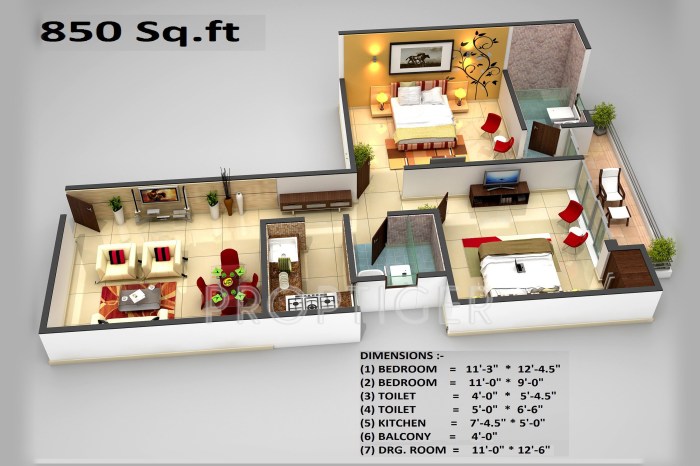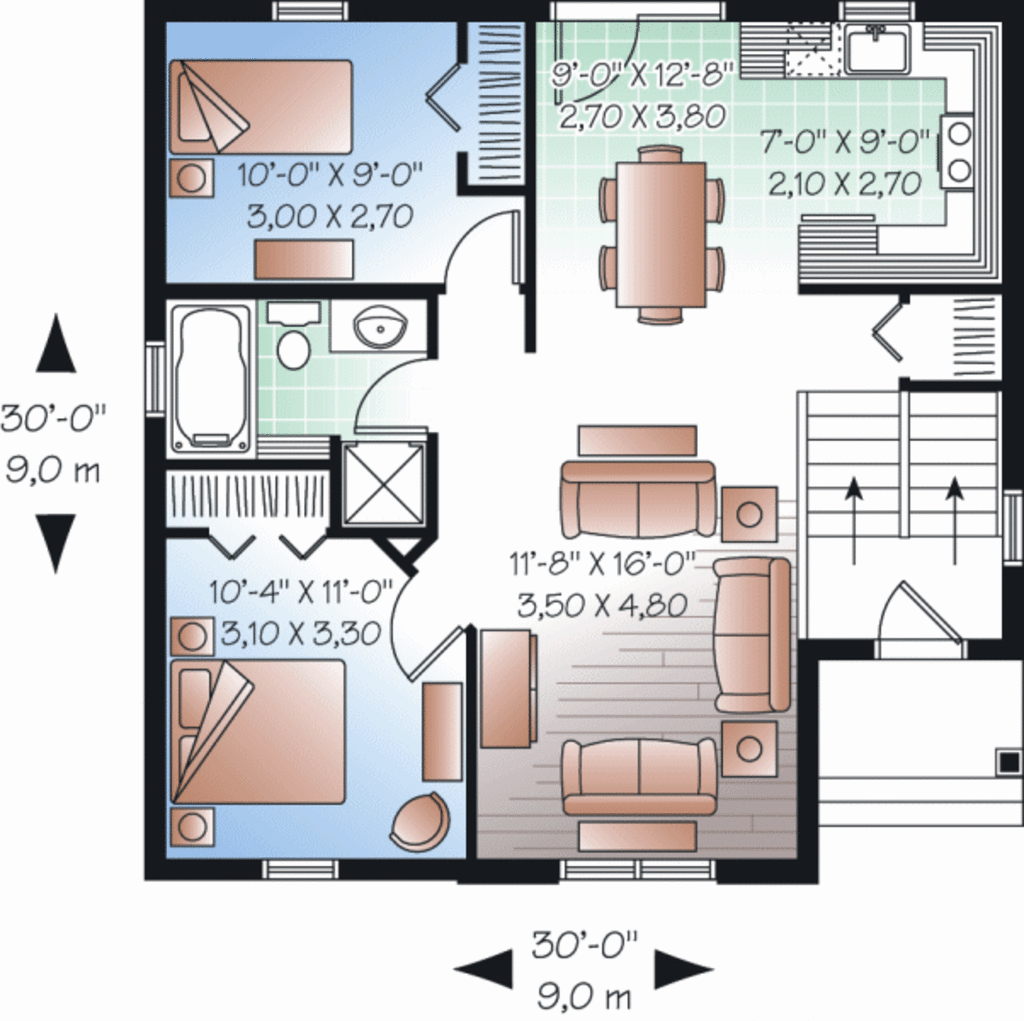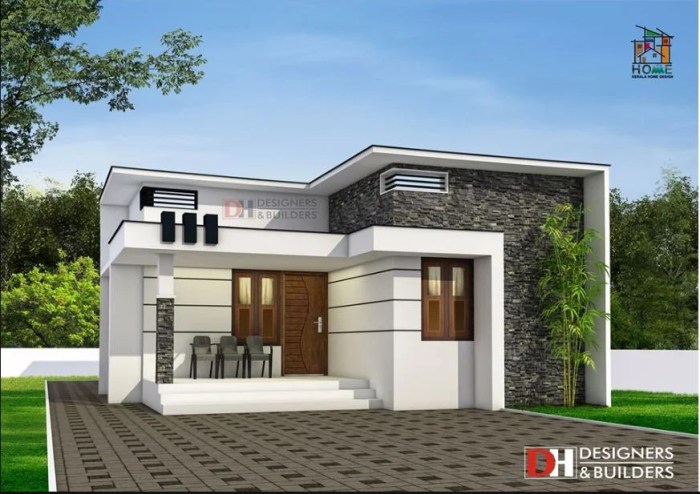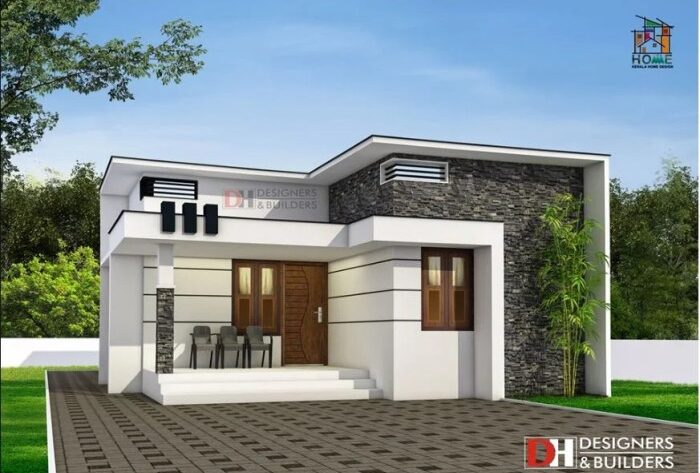850 sq ft house interior design presents a unique challenge: creating a functional and stylish home within a compact footprint. This guide explores the art of maximizing space, optimizing layout, and selecting furniture and décor that enhance both aesthetics and functionality.
Whether you’re embarking on a new build or renovating an existing home, these strategies will help you transform your 850 sq ft space into a haven of comfort and style.
The journey begins with understanding the limitations and possibilities of a smaller home. By carefully planning the layout, you can create a sense of spaciousness and flow, ensuring that every square foot is utilized effectively. A well-designed layout allows for seamless movement between rooms, while clever storage solutions keep clutter at bay and maximize usable space.
Understanding the Space

Designing the interior of an 850 sq ft house presents unique challenges. While it may seem small, with careful planning and design, you can create a comfortable and functional space.
Maximizing Space
Maximizing space is crucial in a smaller home. Every square foot counts, so you need to be strategic with your furniture placement and storage solutions.
Layout and Flow
The layout and flow of your home significantly impact its functionality. A well-designed layout ensures easy movement throughout the house, while a poor layout can create bottlenecks and make the space feel cramped.
Choosing a Design Style
When designing an 850 square foot home, it’s important to choose a style that maximizes space and creates a cohesive aesthetic. There are several popular design styles that are well-suited for smaller homes.
Designing an 850 sq ft house interior can be a fun challenge, especially when considering the efficient use of space. If you’re looking for inspiration on how to maximize smaller spaces, check out this guide on 350 sq ft house interior design.
The principles of smart design can be applied to any size, and the lessons learned from smaller spaces can be valuable for larger ones as well.
Benefits of Popular Design Styles, 850 sq ft house interior design
Choosing the right design style for your 850 square foot home is crucial to creating a space that feels both functional and aesthetically pleasing. Popular choices like minimalist, Scandinavian, and contemporary design offer distinct benefits for smaller spaces.
- Minimalist Design: This style prioritizes simplicity and functionality. It emphasizes clean lines, neutral colors, and minimal furniture. Minimalist design can make a small space feel larger by reducing clutter and maximizing natural light.
- Scandinavian Design: This style is known for its focus on natural materials, light colors, and functionality. It embraces a sense of simplicity and warmth, making it ideal for creating a cozy and inviting atmosphere in a smaller space.
- Contemporary Design: This style is characterized by its sleek, modern lines and bold use of color. It embraces open floor plans and a minimalist approach to furniture, creating a spacious and sophisticated feel.
Lighting and Decor

In a small home, maximizing natural light is crucial for creating a spacious and inviting atmosphere. A well-designed lighting plan, incorporating both natural and artificial light sources, can significantly enhance the overall ambiance and functionality of an 850 sq ft space.
Decorative accents play a vital role in complementing the lighting scheme and adding personality to the design.
Maximizing Natural Light
Natural light is a powerful tool for making a small home feel larger and brighter. It also contributes to a sense of well-being and can help regulate sleep cycles.
- Maximize Window Size and Placement:If possible, enlarge existing windows or add new ones to allow more sunlight to enter the home. Strategically placing windows to maximize sunlight exposure throughout the day is essential.
- Use Light-Colored Paint:Light-colored walls and ceilings reflect natural light, making the space feel brighter and more expansive.
- Minimize Obstructions:Keep windows and doorways clear of furniture and clutter to allow sunlight to flow freely.
- Utilize Mirrors:Mirrors strategically placed opposite windows can reflect natural light, creating the illusion of more space and depth.
- Choose Sheer Curtains:Sheer curtains allow natural light to filter through while still providing privacy. Avoid heavy drapes that block out sunlight.
Designing a Lighting Plan
A well-designed lighting plan combines natural light with strategically placed artificial light sources to create a balanced and functional environment.
- Ambient Lighting:Provides overall illumination for the entire space. Consider using recessed lighting, pendant lights, or track lighting for general illumination.
- Task Lighting:Provides focused light for specific activities, such as reading, cooking, or working. Use desk lamps, under-cabinet lighting, or pendant lights over kitchen islands.
- Accent Lighting:Highlights architectural features, artwork, or decorative elements. Use spotlights, sconces, or picture lights to draw attention to specific areas.
- Dimmable Lighting:Provides flexibility in adjusting the brightness of light sources to suit different moods and activities.
- Layered Lighting:Combining different types of lighting creates a more dynamic and visually appealing atmosphere. This can be achieved by using a combination of ambient, task, and accent lighting.
Decorative Accents
Decorative accents play a crucial role in adding personality and style to a small home. They can also enhance the overall design by creating visual interest and adding warmth to the space.
- Artwork:Artwork can add color, texture, and a focal point to a room. Consider using mirrors, paintings, photographs, or sculptures to enhance the design.
- Throw Pillows and Blankets:These can add pops of color and texture to furniture, making the space feel more inviting and comfortable.
- Rugs:Rugs can define areas within a room, add warmth, and create visual interest. They can also help to tie together different elements of the design.
- Plants:Plants add life and freshness to a space, and can also help to purify the air. Choose plants that thrive in the available light conditions.
- Lighting Fixtures:Lighting fixtures can be a statement piece in a room. Choose fixtures that complement the overall design style and enhance the lighting plan.
Kitchen Design: 850 Sq Ft House Interior Design
Designing a kitchen for an 850 square foot house presents unique challenges. The space is likely to be smaller, requiring clever solutions to maximize functionality and style.
Efficient Kitchen Layouts
A well-planned layout is crucial for a small kitchen. It ensures efficient movement and ample workspace. Here are some efficient layouts for a small space:
- Galley Kitchen:This layout features two parallel countertops with appliances and cabinets in between. It’s ideal for small spaces as it maximizes counter space and storage.
- L-Shaped Kitchen:This layout creates a natural work triangle, with the sink, stove, and refrigerator forming the three corners.
It’s versatile and allows for ample counter space and storage.
- U-Shaped Kitchen:This layout offers a more enclosed feel, with countertops and cabinets forming three sides of the space. It’s ideal for smaller kitchens with a limited footprint.
Open Shelving and Compact Appliances
Open shelving and compact appliances are excellent choices for small kitchens.
- Open Shelving:Open shelving can create a more airy and spacious feel in a small kitchen. It also provides easy access to frequently used items. However, it requires careful organization and a minimalist approach to avoid clutter.
- Compact Appliances:Compact appliances, such as mini-fridges, countertop ovens, and small dishwashers, can save valuable space in a small kitchen.
They offer the same functionality as their larger counterparts but in a smaller footprint.
Creating a Functional and Stylish Kitchen
Here are some tips for creating a functional and stylish kitchen in a small space:
- Maximize Vertical Space:Utilize vertical space with tall cabinets, shelves, and wall-mounted organizers to maximize storage.
- Choose Light Colors:Light colors, such as white or cream, can make a small kitchen feel larger and brighter.
- Use Mirrors:Mirrors can reflect light and create the illusion of more space.
- Incorporate Natural Light:Maximize natural light by keeping windows unobstructed and using light-colored curtains or blinds.
- Choose Multifunctional Furniture:Opt for furniture that serves multiple purposes, such as a kitchen island that doubles as a dining table or a bar cart that can also be used for storage.
Bedroom Design
The bedroom is your sanctuary, a place to unwind and recharge after a long day. Designing a bedroom that promotes relaxation and comfort is crucial for a good night’s sleep and overall well-being. This section will guide you through creating a calming and inviting atmosphere in your 850 sq ft house.
Creating a Calming and Inviting Atmosphere
A well-designed bedroom fosters a sense of tranquility and encourages restful sleep. Here are some tips to create a calming and inviting atmosphere:
- Choose a Serene Color Palette:Opt for soft, muted colors like pale blues, greens, or grays. These colors promote relaxation and create a sense of peace. Avoid overly bright or stimulating colors that can keep you awake.
- Incorporate Natural Elements:Bring the outdoors in with natural materials like wood, bamboo, or stone. These elements add warmth and grounding to the space.
- Minimize Clutter:A cluttered bedroom can feel overwhelming and stressful. Keep surfaces clear and store items in drawers or closets.
- Add Soft Textures:Incorporate soft textiles like plush rugs, cozy throws, and luxurious bedding. These textures create a sense of comfort and invite you to relax.
- Choose the Right Lighting:Avoid harsh overhead lighting. Instead, opt for soft, warm lighting from lamps or sconces. You can also use dimmer switches to adjust the brightness according to your mood.
Using Color, Textiles, and Lighting to Enhance Sleep Quality
The color palette, textiles, and lighting you choose can significantly impact your sleep quality.
- Color:As mentioned earlier, calming colors like blues, greens, and grays can promote relaxation and improve sleep. Avoid bright, stimulating colors like red or orange, which can excite the nervous system and make it harder to fall asleep.
- Textiles:Choose natural fabrics like cotton, linen, or wool for bedding and throws. These materials are breathable and comfortable, promoting a restful sleep. Avoid synthetic fabrics that can trap heat and moisture.
- Lighting:Dimming the lights in the evening signals to your body that it’s time to wind down. Avoid using electronic devices like smartphones or tablets in the hour before bed, as the blue light emitted from these devices can interfere with melatonin production, a hormone that regulates sleep.
Maximizing Natural Light
Natural light plays a crucial role in making a small home feel larger and more inviting. It can brighten up the space, enhance the mood, and create a sense of openness. Maximizing natural light in your 850 square foot home is essential for creating a comfortable and visually appealing living environment.
Window Placement and Design
Window placement and design are critical for maximizing natural light. Strategic placement can ensure that light reaches every corner of your home, while thoughtful design choices can enhance the flow of light.
- Maximize Window Size:Larger windows allow more natural light to enter the home. Consider replacing small windows with larger ones or installing French doors to increase the amount of light that enters.
- Consider Window Placement:Strategically placing windows on opposite sides of the room can create a cross-ventilation effect, allowing light to flow through the space.
- Choose the Right Window Type:Different window types offer varying degrees of light transmission. For maximum light, consider using clear glass windows or skylights.
- Minimize Obstructions:Ensure that furniture and other objects are not blocking windows. Consider using sheer curtains or blinds to allow light to filter through.
Interior Design Elements that Enhance Natural Light
Interior design elements can amplify and reflect natural light, creating a brighter and more spacious feel.
- Light Colors:Using light-colored walls, ceilings, and furniture reflects light, making the space appear larger and brighter.
- Mirrors:Strategically placed mirrors can reflect natural light, doubling the amount of light in a room. Consider placing a mirror opposite a window to create a sense of depth and brightness.
- Glass Partitions:Glass partitions between rooms allow light to flow freely, creating a sense of openness and connectivity.
- Light-Colored Flooring:Light-colored flooring reflects light, making the space feel larger and brighter.
Final Thoughts

Designing an 850 sq ft house interior is a rewarding endeavor, one that requires a blend of creativity, practicality, and attention to detail. By embracing the principles of efficient space planning, incorporating a cohesive design style, and prioritizing functionality, you can create a home that is both beautiful and comfortable.
Remember, the key is to maximize every inch of space, embracing multi-functional furniture, clever storage solutions, and a well-thought-out color palette to create a sense of openness and inviting ambiance.
FAQ Guide
What are some common challenges of designing an 850 sq ft house?
Limited space, maximizing functionality, creating a sense of openness, and choosing furniture that fits the scale of the home are some common challenges.
How can I make my 850 sq ft house feel bigger?
Use light colors, maximize natural light, incorporate mirrors, and choose furniture with clean lines and minimal bulk.
What are some essential storage solutions for a small home?
Built-in shelves, under-bed storage, vertical organizers, and multi-functional furniture with hidden storage compartments are excellent options.




